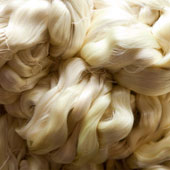Design Resource
Mysore Silk
The Making of Silk Textile
by
Prof. Bibhudutta Baral J. Antony William and C. Susanth
Soaking, Twisting, Wefting and Winding:
Soaking:
Coconut oil is used as it makes the fabric soft for temporary coloring. The temporary coloring is done for identifying the warps and the wefts.
Equipment used:
Steam supplied by Boiler House to Aluminum Tubs.
Plastic water Container.
Precautions:
Checking the Boiler Steam Pressure.
Preparation:
Dividing the Raw Silk Yarn indented for Warp and Weft as per production plan.
Activity/Steps:
a. Warp:
Boil Water and add soap 2.5 to 3.5% on weight of material and allow the soap to melt completely (About 15 minutes). Add 6% to 8% of coconut oil on weight of material and boil till the coconut oil emulsifies Completely (15-20 minutes). Shift the concentrated solution to plastic container and dilute the solution to required level. Add tinted color (if necessary) and rinse the silk- Hand squeeze and hydro extract. Dress and dry in shade. After completely drying shift the material to soaked silk yarn stores.
b. Weft:
Boil water and add 2% to 3.5% Soap on weight of material and allow the soap to melt completely (About 20 minutes). Add 6% to 8% Coconut Oil on weight of material and boil till the coconut oil emulsifies Completely (25-30 Minutes). Divide the solution into two equal parts and add “ Blue” color tint For “S” Direction and dilute the solution to required level and steep the silk for approximately 3 to 4 hours. Add “Orange” color tint fot Z directions and dilute the solution to the required level and steep the silk for approximately 3 to 4 hours. Rinse and remove the material, hand squeezer and dress and dry in shade. Both orange colored and Blue colored dressed separately on GI pipes. After completely drying, shift the material to soaked silk yarn stores lot wise.
Dressing:
The semi-dry silk bundles are tied to form a circle and are hung on G.I pipes until they become completely dry. Straightening of silk fibers are done manually by jerking them at regular intervals to take away any water content.
Weft Section:
Winding: The above winding process is common for both the making of the warps and the wefts.
Doubling: Here, the silk thread is doubled by running two threads simultaneously from two different bobbins onto a single bobbin and passed onto twisting.
1st Twisting:
This section consists of 4 machines.
The machines consist of rubber roller to provide tension while twisting.
The doubled weft threads are twisted:
Blue tinted thread are given an ‘S’ Twist in a Clockwise direction.
Orange tinted thread are given an ‘Z’ Twist in an Anti-clockwise direction.
400 twists are made at this stage.
1st Re-winding:
This section consists of 4 machines.
The thread from the bobbins is now wound around a barrel.
These barrels are sent into the Vacuum Heat Shelter.
Steaming:
The silk threads wound around perforated hollow aluminum pipes are called barrels. The perforations allow the steam to enter on the insides and spread the temporary color equally. Up to 200 barrels from a machine can be accommodated in the steam chamber. Barrels from 3 such machines are placed for a period of 40 minutes for steaming.
2nd Twisting:
1800 twists are made at this stage.
Therefore, the total no. of twists amount to 2200.
Final Re-winding:
They are now transferred to bobbins.
The bobbins now move onto the pirn winding section under the weaving section.
Pirn Winding:
This section consists of 12 machines of 6 pirns each.
The machines transfer the thread from the bobbins onto the pirns that fit into the shuttles for weaving. This is done only for the wefts.
Cone Winding:
Double Winding:
Single Winding:
Soaking:
Steaming:
Twisting:
Weft:





















































